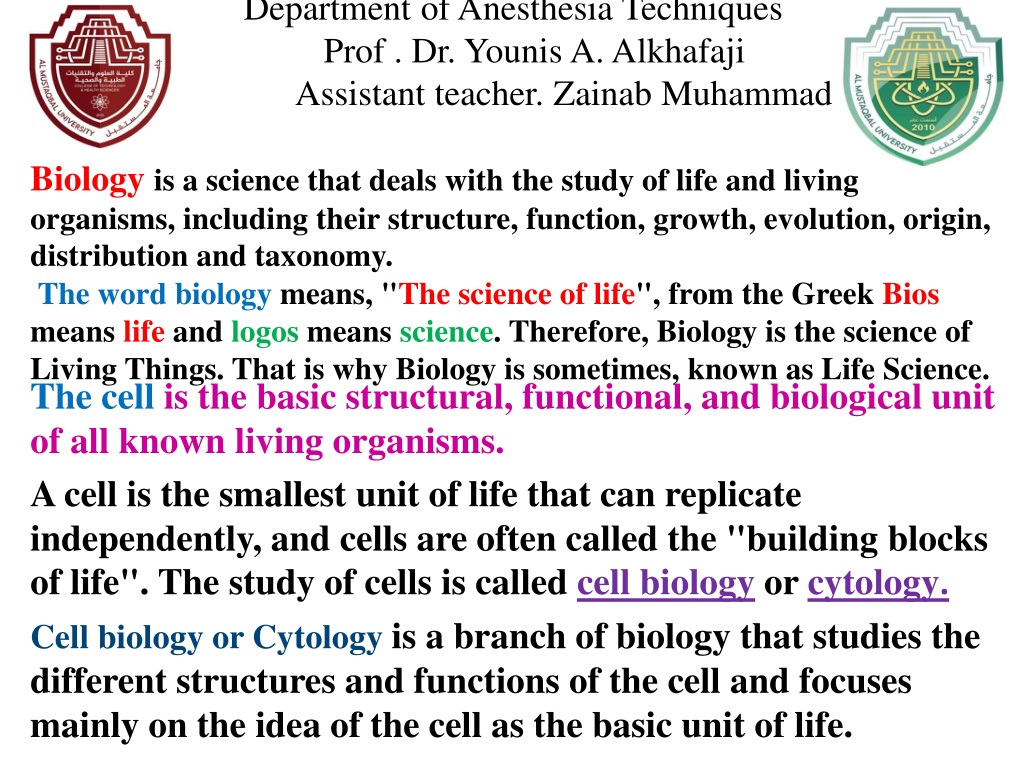
Understanding Cell Biology: The Basic Unit of Life and Its Significance
Explore the fascinating world of cell biology, where the study of cells as the fundamental units of life reveals insights into the structure, function, and classification of living organisms. Delve into the cell theory, cell types, and the intricate organization within cells, shedding light on their crucial role in the living world.
Download Presentation

Please find below an Image/Link to download the presentation.
The content on the website is provided AS IS for your information and personal use only. It may not be sold, licensed, or shared on other websites without obtaining consent from the author. Download presentation by click this link. If you encounter any issues during the download, it is possible that the publisher has removed the file from their server.
E N D
Presentation Transcript
Department of Anesthesia Techniques Prof . Dr. Younis A. Alkhafaji Assistant teacher. Zainab Muhammad Biology is a science that deals with the study of life and living organisms, including their structure, function, growth, evolution, origin, distribution and taxonomy. The word biology means, "The science of life", from the Greek Bios means life and logos means science. Therefore, Biology is the science of Living Things. That is why Biology is sometimes, known as Life Science. The cell is the basic structural, functional, and biological unit of all known living organisms. A cell is the smallest unit of life that can replicate independently, and cells are often called the "building blocks of life". The study of cells is called cell biology or cytology. Cell biology or Cytology is a branch of biology that studies the different structures and functions of the cell and focuses mainly on the idea of the cell as the basic unit of life.
Cell biology explains the structure, organization of the organelles they contain, their physiological properties, metabolic processes, Signaling pathways, life cycle, and interactions with their environment. Organisms can be classified as unicellular (consisting of a single cell; including bacteria) and Archaea multicellular (including plants and animals). While the number of cells in plants and animals varies from species to species, humans contain more than 10 trillion (1012) cells.
Cell theory Robert Hooke in (1665) who described the cella (open spaces) of plant tissues discovered the cell. The cell theory is a widely accepted explanation of the relationship between cells and living things. The cell theory states: 1. All organisms are composed of cells. 2. Cell is the structural and functional unit of life. 3. Cells arise from pre-existing cells. The cells vary considerably, in shape and size. Nerve cells of animals have long extensions. They can be several feet in length. Muscle cells are elongated in shape. Egg of the ostrich is the largest cell (75 mm). Some plant cells have thick walls. There is also wide variation in the number of cells in different organisms.
Cell types There are two distinctive types of cells 1- Prokaryotic cells: Prokaryotes lack a nucleus (though they do have circular DNA) and other membrane-bound organelles (though they do contain ribosomes). Bacteria and Archaea are two domains of prokaryotes. 2- Eukaryotic cells: Eukaryotes, have distinct nuclei bound by a nuclear membrane and membrane-bound organelles (mitochondria, chloroplasts, lysosomes, rough and smooth endoplasmic reticulum, vacuoles). In addition, they possess organized chromosomes which store genetic material. Protists, fungi, animals, and plants all consist of eukaryotic cells. ( Protist is an informal term referring to a group of mostly unicellular eukaryotes) .
Table 1: Comparison of features of prokaryotic and eukaryotic cells Prokaryotes bacteria, archaea Eukaryotes Typical organisms protists, fungi, plants, animals Typical size ~ 1 5 m ~ 10 100 m Type of nucleus nucleoid region; no true nucleus circular (usually) true nucleus with double membrane linear molecules (chromosomes) with histone proteins RNA synthesis in the nucleus protein synthesis in the cytoplasm 60S and 40S DNA RNA/protein synthesis coupled in the cytoplasm Ribosomes 50S and 30S Cytoplasmic structure very few structures highly structured by endomembranes and a cytoskeleton Flagella and cilia containing microtubules; lamellipodia and filopodia containing actin Cell movement flagella made of flagellin
Continue Prokaryotes Eukaryotes Mitochondria Chloroplasts Organization none none usually single cells one to several thousand in algae and plants single cells, colonies, higher multicellular organisms with specialized cells mitosis (fission or budding) meiosis Cell division binary fission (simple division) Chromosomes single chromosome More than one chromosome Membranes Cell membranes Cell membrane and membrane-bound organelles
Plant cell Animal cell Plant cell surrounded by a rigid cell wall Larger in size Plant cells have plastids Animal cells do not have a cell wall Smaller in size Animal cells do not have plastids Whereas there are very small vacuoles as compared to plant cells are seen in animal cells. Animal cells have centrosomes. Presence of a large vacuole is seen in plant cells. Centrosomes are absent in plant cells















